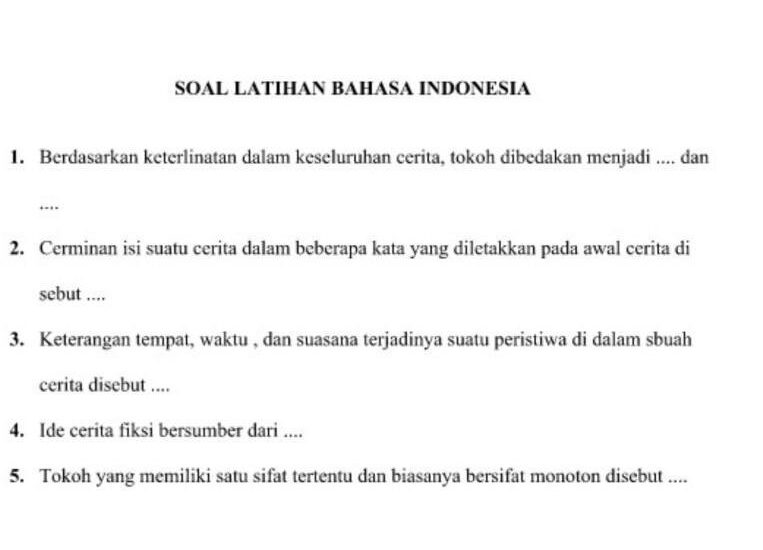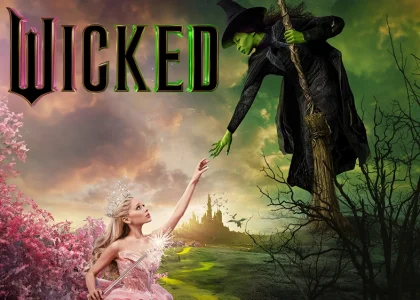A cerminan isi suatu cerita dalam beberapa kata yang diletakkan pada awal cerita disebut prolog. This essential element sets the tone and gives readers a glimpse into the narrative that awaits them. It acts as a compelling invitation, drawing readers into the world crafted by the author.
By using well-chosen words, a prolog can evoke emotions, spark curiosity, and create anticipation for the unfolding tale. In this article, we will explore the significance of this storytelling device and how it enriches the reader’s experience.
Cerminan Isi Suatu Cerita Dalam Beberapa Kata Yang Diletakkan Pada Awal Cerita Disebut
When we dive into the world of storytelling, the beginning of a tale often holds the key to the entire narrative. In literature, the phrase or sentence placed at the beginning of a story that reflects its essence is commonly known as the “prologue” or “hook.” This introduction serves several purposes, such as grabbing the reader’s attention, providing a glimpse of the plot, or setting the tone. This article explores the significance and characteristics of this vital component of storytelling.
The Importance of the Opening Lines
The first few lines of a story are crucial. They do more than just introduce characters or settings; they create an impression, establish mood, and hint at the themes that will unfold. Here are some reasons why these opening lines matter:
- Captures Attention: In a crowded marketplace of stories, the hook needs to draw readers in, making them want to read more.
- Sets the Tone: The mood established in the beginning can shape how readers feel throughout the story.
- Provides Context: It can offer essential background information that helps readers understand the unfolding events.
- Invites Curiosity: Leaving questions unanswered in the opening can engage readers’ imaginations, prompting them to continue reading.
- Foreshadowing: Good opening lines often hint at the conflicts and resolutions that will come later in the narrative.
Characteristics of Effective Opening Lines
What makes an opening line effective? Let’s break down some of the crucial attributes that contribute to a powerful introduction.
Conciseness
Effective opening lines are often brief and to the point. They convey significant meaning in just a few words. This conciseness ensures that the reader quickly grasps the story’s essence without wading through unnecessary detail.
Engaging Language
Language plays a pivotal role in storytelling. The choice of words can evoke emotions and paint vivid imagery in the reader’s mind. Using descriptive and engaging language in the opening lines can create a strong connection between the reader and the story.
Conflict Introduction
Introducing conflict early in the story can spark curiosity. Readers often want to understand the struggles characters face, making it essential to hint at challenges in those first moments of the narrative.
Character Insight
Sometimes, effective opening lines provide a glimpse into the protagonist’s thoughts or feelings. This insight can help readers relate to the character right from the start.
Examples of Powerful Opening Lines
To illustrate the effectiveness of well-crafted opening lines, let’s take a look at some examples from literature and their impact.
“It was the best of times, it was the worst of times…”
This famous line from Charles Dickens’ *A Tale of Two Cities* sets a profound tone, immediately presenting a dichotomy that resonates throughout the novel. The contrast piques interest and establishes a foundation for the themes of duality explored in the story.
“Call me Ishmael.”
In Herman Melville’s *Moby Dick*, this simple introduction creates a personal connection between the narrator and the reader. The direct appeal engages readers while also setting a tone for the adventures that will follow.
“All happy families are alike; each unhappy family is unhappy in its own way.”
Leo Tolstoy’s opening line from *Anna Karenina* succinctly encapsulates a central theme of the book – happiness and suffering in family life. This line not only hooks the reader but also foreshadows the complex dynamics that will unfold.
“In my younger and more vulnerable years my father gave me some advice that I’ve been turning over in my mind ever since.”
F. Scott Fitzgerald begins *The Great Gatsby* with a reflective tone, inviting readers into the narrator’s past. This opening sets the scene for themes of nostalgia and the exploration of identity.
Crafting Your Own Opening Lines
Now that we understand the importance of these initial lines, let’s discuss how to craft your own. Here are some strategies to consider when writing your opening lines:
Start with a Question
Questions stimulate curiosity. Consider starting your story with a question that challenges readers to think or imagine possibilities.
Paint a Vivid Picture
Use descriptive language to create vivid imagery that immerses readers into the story world. This approach helps set a scene that captures interest instantly.
Introduce a Character
Begin with a character’s inner thoughts or a defining action. This method draws readers into the character’s emotional journey right away.
Use a Quote
Incorporating a relevant quote can add depth and provoke thought. Quotes can also set the tone or theme for your story.
The Role of Foreshadowing in Opening Lines
Foreshadowing is an essential literary device that provides hints about events to come. Opening lines can incorporate foreshadowing to create suspense and intrigue. Here are some ways to weave foreshadowing into your introductory lines:
- Subtle Hints: Offer slight clues about future events or character arcs without revealing too much.
- Imagery: Use symbolic imagery that may carry significance later in the story.
- Dialogue: Start with dialogue that may seem ordinary but hints at deeper issues or conflicts.
The Connection Between Opening Lines and Theme
The opening lines play a significant role in establishing the thematic elements of a story. They can reflect the overarching themes or moral lessons that will unfold. Here’s how to ensure your opening connects with the theme:
Identify Your Theme
Before writing your opening lines, have a clear understanding of the themes you want to convey. Whether it’s love, loss, identity, or friendship, knowing your theme can help craft a meaningful introduction.
Utilize Symbolic Language
Incorporate symbols or motifs that will recur throughout the story. This approach deepens the reader’s understanding of the theme right from the start.
Set the Emotional Tone
Consider how the emotions in your opening lines can reflect the thematic journey of your characters. Aligning the emotional tone with your themes strengthens the narrative.
A Common Mistake: Overloading the Opening
One common mistake writers make is to overload the opening lines with too much information. While it’s important to provide necessary context, avoid information dumps that can overwhelm readers. Here are some tips to keep your opening focused:
- Start In the Midst of Action: Place readers in the middle of an event rather than explaining too much background.
- Limit Characters: Introduce one or two main characters to avoid confusion.
- Focus on One Idea: Stick to one main idea or image to convey the essence of the story.
The Impact of Cultural Context on Opening Lines
Cultural context can also influence how readers perceive opening lines. Different cultures may have varying expectations for storytelling. Understanding your audience can help tailor your opening to resonate more effectively. Here are some considerations:
Language Style
Different cultures have distinct styles of language and expression. Be mindful of idioms, colloquial language, or stylistic norms that may resonate with your intended audience.
Familiar Themes
Certain themes may hold more significance in specific cultural contexts. Consider using themes that will resonate with the values or experiences of your readers.
Genre Expectations
Genres often come with conventions. A mystery story’s opening might lean toward suspense, while a romance may want to evoke emotions immediately. Tailor your opening to meet genre expectations.
Analyzing Successful Openings in Various Genres
Opening lines differ across genres, each with its unique style and purpose. Let’s explore how different genres approach their introductions.
Fiction
Fiction often starts with relatable characters in everyday situations. The opening is designed to connect readers emotionally. For example, contemporary fiction often begins with internal monologues or relatable scenarios that invite readers in.
Sci-Fi/Fantasy
In sci-fi or fantasy, the opening often introduces the world-building element. Readers need to understand the setting and rules of the universe quickly. For example, an opening line might describe a unique aspect of the world that intrigues and pulls readers in.
Thriller/Mystery
Thrillers often open with a shocking event or significant tension. The goal is to grab immediate attention. An effective opening might involve a mysterious situation or a character in peril, compelling readers to find out what happens next.
Non-Fiction
Non-fiction openings can start with a compelling fact, anecdote, or question that resonates with the audience’s curiosity. For example, a health article may open with surprising statistics that highlight the topic’s relevance.
By understanding these genre-specific strategies, you can craft opening lines that align with reader expectations while also standing out.
Revising Your Opening Lines
Once you’ve crafted your initial opening lines, it’s crucial to revisit them during the revision process. Here are some tips for revising effectively:
- Read Aloud: Hearing the lines can help identify
Materi Cermin oleh Kel 4 SMP N 8 Salatiga
Frequently Asked Questions
What is the purpose of placing a summary at the beginning of a story?
A summary at the beginning of a story provides readers with a quick insight into the main themes and ideas of the narrative. It helps set the tone and prepares the audience for the unfolding plot. By understanding the essence of the story early on, readers can engage more effectively with the material.
How does a concise summary influence reader engagement?
A concise summary can significantly enhance reader engagement by sparking interest. When readers grasp the core premise right away, they feel encouraged to delve deeper into the story. This early insight can create curiosity about how the plot will develop and how characters will evolve.
Can a story’s summary change its interpretation?
Yes, a story’s summary can influence its interpretation. A well-crafted summary can shape the reader’s expectations and frame their understanding of the narrative. Depending on how the summary presents key themes or conflicts, it can lead readers to perceive the story in a specific light, affecting their overall experience.
What elements should be included in a story summary at the beginning?
A good story summary should include the central conflict, main characters, and setting. It should capture the essence of the plot succinctly while providing enough context to entice readers. This way, the summary not only outlines what to expect but also intrigues the audience to continue reading.
Is there a standard length for a story summary at the beginning?
There is no strict standard length for a story summary, but it typically ranges from one to several sentences. The goal is to be concise while conveying essential information. A summary should be brief enough to maintain interest but comprehensive enough to give a clear picture of what the story entails.
Final Thoughts
Cerminan isi suatu cerita dalam beberapa kata yang diletakkan pada awal cerita disebut sinopsis. A concise summary engages readers and sets the tone for what’s to come. It offers a glimpse into the characters, themes, and plot, drawing the audience into the narrative.
By providing this insight, a sinopsis serves as a valuable tool for understanding the essence of the story, making it easier for readers to decide if they want to delve deeper into the text.






